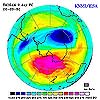| . |  |
. |
Scientists from NASA and the Commerce Department's National Oceanic and Atmospheric Administration (NOAA) have confirmed the ozone hole over the Antarctic this September is not only much smaller than it was in 2000 and 2001, but has split into two separate "holes." The researchers stressed the smaller hole is due to this year's peculiar stratospheric weather patterns and that a single year's unusual pattern does not make a long-term trend. Moreover, they said, the data are not conclusive that the ozone layer is recovering. Paul Newman, a lead ozone researcher at NASA's Goddard Space Flight Center, Greenbelt, Md., said this year, warmer-than- normal temperatures around the edge of the polar vortex that forms annually in the stratosphere over Antarctica are responsible for the smaller ozone loss. Estimates for the last two weeks of the size of the Antarctic Ozone Hole (the region with total column ozone below 220 Dobson Units), from the NASA Earth Probe Total Ozone Mapping Spectrometer (EPTOMS) and the NOAA-16 Solar Backscatter Ultraviolet instrument (SBUV/2), are around 15 million square kilometers (6 million square miles). These values are well below the more-than 24 million sq. km. (9 million sq. mi.) seen the last six years for the same time of year. The stratosphere is a portion of the atmosphere about 6-to-30 miles above the Earth's surface where the ozone layer is found. The ozone layer prevents the sun's harmful ultraviolet radiation from reaching the Earth's surface. Ultraviolet radiation is a primary cause of skin cancer. Without protective upper-level ozone, there would be no life on Earth. "The Southern Hemisphere's stratosphere was unusually disturbed this year," said Craig Long, meteorologist at NOAA's Climate Prediction Center (CPC). The unusual weather patterns were so strong, the ozone hole split into two pieces during late September. NOAA's CPC has been monitoring and studying the ozone since the early 1970s. "This is the first time we've seen the polar vortex split in September," said Long. At South Pole Station, balloon-borne ozone-measuring instruments launched by NOAA's Climate Monitoring and Diagnostics Laboratory (CMDL) reveal the vertical structure of the developing ozone hole. Bryan Johnson, a scientist with CMDL, said the main ozone depletion region, from 7-to-14 miles above the Earth, has large ozone losses, similar to the last few years. At more than 15 miles above the Earth, surface measurements show higher-than-normal ozone concentrations and higher temperatures. The combination of these layers indicate total ozone levels in a column of atmosphere will be higher than observed during the last few years, Johnson said. However, some layers may still show complete ozone destruction by early October, when ozone depletion is greatest. In 2001, the Antarctic ozone hole was larger than the combined area of the United States, Canada and Mexico. The last time the ozone hole was this small was in 1988, and that was also due to warm atmospheric temperatures. "While chlorine and bromine chemicals cause the ozone hole, temperature is also a key factor in ozone loss," Newman said. The Montreal Protocol and its amendments banned chlorine- containing chlorofluorocarbons (CFCs) and bromine-containing halons in 1995, because of their destructive effect on the ozone layer. However, CFCs and halons are extremely long- lived and still linger at high concentrations in the atmosphere. The coldest temperatures over the South Pole typically occur in August and September. Thin clouds form in these cold conditions, and chemical reactions on the cloud particles help chlorine and bromine gases to rapidly destroy ozone. By early October, temperatures usually begin to warm, and thereafter the ozone layer starts to recover. NOAA and NASA continuously observe Antarctic ozone with a combination of ground, balloon, and satellite-based instruments.
Links at GSFC Report SpaceDaily Search SpaceDaily Subscribe To SpaceDaily Express  Paris (ESA) Sep 24, 2002
Paris (ESA) Sep 24, 2002Based on satellite data from the European Space Agency, the national meteorological centre of the Netherlands predicts the Antarctic ozone hole will break apart this week, months earlier than usual.
|
| ||||||||||
| The content herein, unless otherwise known to be public domain, are Copyright 1995-2016 - Space Media Network. All websites are published in Australia and are solely subject to Australian law and governed by Fair Use principals for news reporting and research purposes. AFP, UPI and IANS news wire stories are copyright Agence France-Presse, United Press International and Indo-Asia News Service. ESA news reports are copyright European Space Agency. All NASA sourced material is public domain. Additional copyrights may apply in whole or part to other bona fide parties. Advertising does not imply endorsement, agreement or approval of any opinions, statements or information provided by Space Media Network on any Web page published or hosted by Space Media Network. Privacy Statement All images and articles appearing on Space Media Network have been edited or digitally altered in some way. Any requests to remove copyright material will be acted upon in a timely and appropriate manner. Any attempt to extort money from Space Media Network will be ignored and reported to Australian Law Enforcement Agencies as a potential case of financial fraud involving the use of a telephonic carriage device or postal service. |